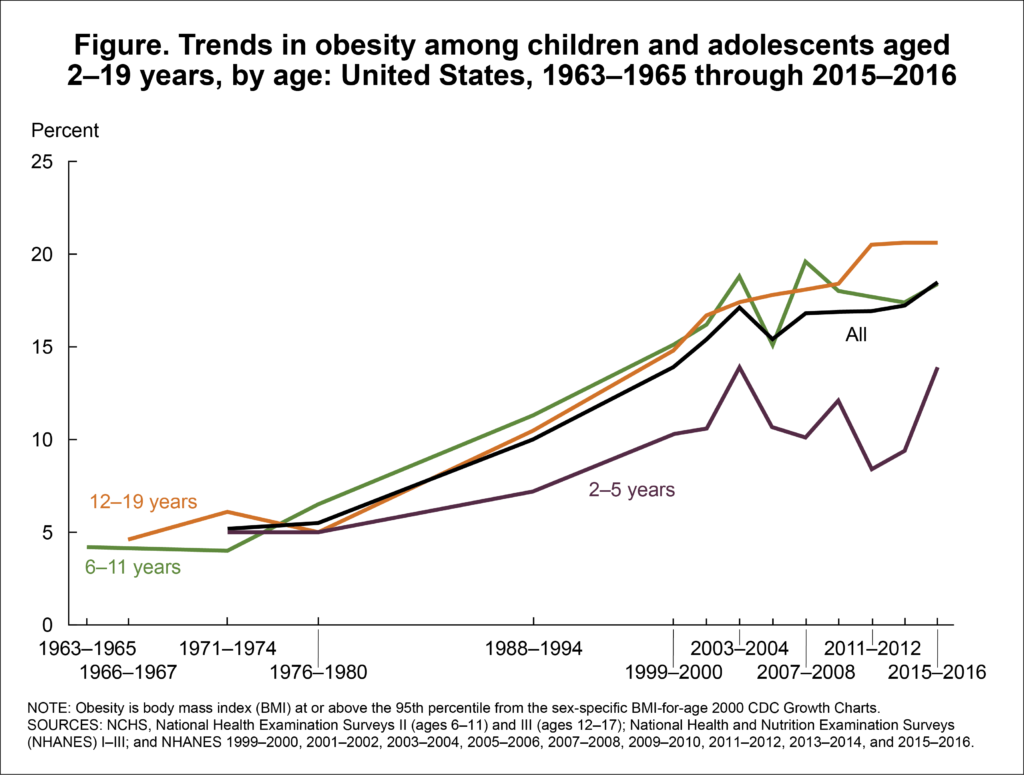SUMMARY, METHODS, AND FINDINGS
The purpose of my research was to examine if fast-food restaurants, specifically McDonald’s, had an effect on the child obesity epidemic through the way they advertised their food to consumers. This question is important to look at due to the fact that fast-food comprises a large part of many American’s diets, and people begin eating fast-food from an early age. Beginning to develop these unhealthy eating patterns early on can lead to diet-related health conditions later in life such as diabetes or cardiovascular disease.
To analyze this question, the methods I used involved collecting McDonald’s advertisements from when they opened in the 1960s until the present. I collected approximately 30 advertisements over the course of this 60-year time frame. Next, I searched for CDC (Centers for Disease Control and Prevention) data from this same time period in order to see the pattern in which child obesity rates had increased or decreased.
I found that since the 1960s, child obesity rates have steadily increased, with only few insignificant decreases. In 1963, the child obesity rate was at 4.4%, and the most recent report from 2018 stated that the prevalence of child obesity was at 19.3%. Today, child obesity has affected approximately 14.4 million children and adolescents. Although obesity can be caused by several factors, I analyzed McDonald’s commercials to see whether there were any changes in advertising based on the child obesity epidemic that was simultaneously emerging.
The most prominent finding was that child obesity rates made a significant jump in 1976, which was when there began to be a shift in the messages within McDonald’s advertisements. For the first 15-20 years of McDonald’s advertising, they tended to focus on the convenience and low prices of their product. Many advertisements depicted families eating together at the McDonald’s restaurant, because that is where they could receive a quality meal for a low price that everyone would love. Additionally, food promotions and tie-ins were incentives for children to want to eat McDonald’s food, which was often an unhealthy meal of a hamburger and french fries. These food promotions have been seen to have a direct effect on children’s nutrition knowledge, preferences, purchase behavior, consumption patterns, and diet-related health (Dixon et al. 2017).

However, between the 1980s and the turn of the century, the messages within the advertisements began to shift. Heavy emphasis was placed on the quality of the nutrients within the food itself and healthier menu items were introduced. This change in advertising strategy lines up with the spike in child obesity rates, suggesting that McDonald’s was trying to address the obesity epidemic that was rapidly spreading. McDonald’s is one of the largest food service companies in the world, and with their kind of widespread presence, its products and marketing practices often draw criticism because of their influence on child health (Lewin, Lindstrom, and Nestle 2006:330).
CONCLUSIONS
My findings align with similar conclusions made by Ronald Adams (2005) who states that the causes of obesity are complex, and it is difficult to isolate the specific role played by fast-food; however, it is evident that both obesity rates and fast-food companies have both grown exponentially. McDonald’s advertisements do attempt to play a role in supporting a healthy lifestyle; however, there are no significant data to prove the effectiveness of their efforts. McDonald’s still offers the unhealthy food options that people tend to consume due to price and convenience, which is contributing the epidemic. Eating behaviors and patterns are one of many factors that can lead to obesity, and Story and French (2004) state that eating behaviors established during childhood can continue into adulthood, potentially contributing to long-term health and disease risk. McDonald’s strategy of pairing of a premium toy with an unhealthy Happy Meal might have an effect on child obesity as children associate McDonald’s food to a form of happiness, and this association may become a learned behavior.
I have detected a correlation between obesity rates and McDonald’s in both directions: McDonald’s fast-food has contributed to rising obesity rates, and as a result, the increasing obesity rates have had an effect on how McDonald’s altered their advertising. However, a child’s health status involves the interaction between individual factors, social factors, environmental factors, and a child’s selection of nutrient consumption and energy expenditure (Eagle et al. 2012:839). Therefore, we cannot claim direct causation that McDonald’s fast-food alone has led to a significant rise in obesity rates due to the other factors that may have a stronger effect.
From my analysis, I conclude that McDonald’s and other fast-food restaurants are a factor in the obesity epidemic, but they are not a significant component because once McDonald’s altered their menu to include more healthful items, there was no substantial decrease in child obesity rates. This alludes to the fact that other factors have more weight in the cause of the epidemic, but the McDonald’s Corporation and fast-food consumption are not significantly helping to fight the child obesity epidemic.
FUTURE RESEARCH
There is significant research supporting the idea that targeted marketing towards children has an effect on their decision-making skills and preferences, however more research could be done on targeted marketing based on geographic or demographic characteristics. Additionally, another avenue for future research could be to investigate the attitudes about weight that may be the products of culture and economic insecurity. Addressing childhood obesity issues may require particular sensitivity in certain cultures or places with more prevalent economic insecurity, and it may be important to recognize these attitudes in relation to the obesity crisis.